Assessment on Strategic Management of Gojek
VerifiedAdded on 2023/04/21
|15
|3810
|401
AI Summary
This report discusses the key ideas of strategic management applied to Gojek's operations in delivering ride-hailing services. It includes Porter's Five Forces analysis, Resource Based View, and an investigation of Gojek's plan to extend services to Singapore. Recommendations are provided based on the findings.
Contribute Materials
Your contribution can guide someone’s learning journey. Share your
documents today.
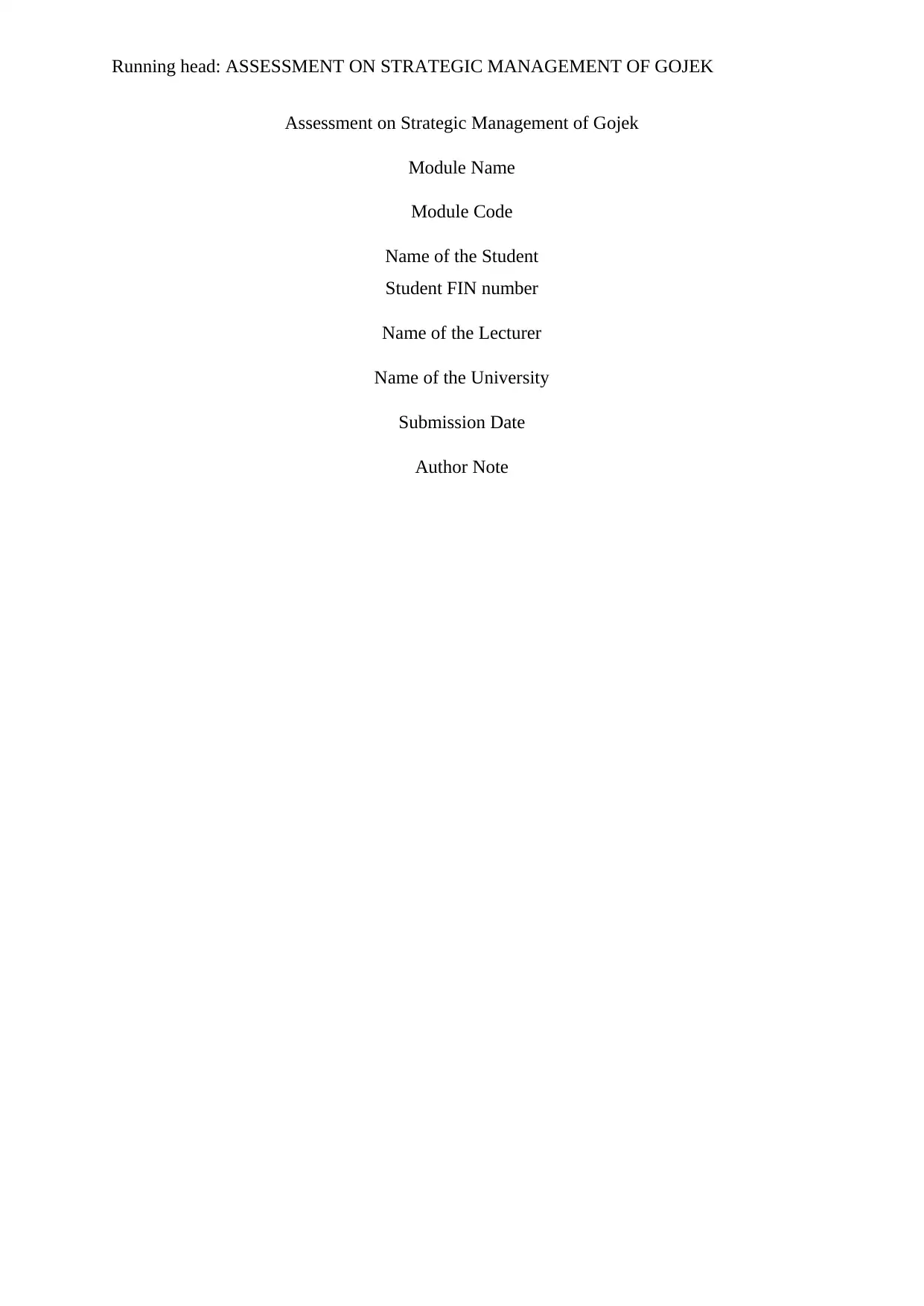
Running head: ASSESSMENT ON STRATEGIC MANAGEMENT OF GOJEK
Assessment on Strategic Management of Gojek
Module Name
Module Code
Name of the Student
Student FIN number
Name of the Lecturer
Name of the University
Submission Date
Author Note
Assessment on Strategic Management of Gojek
Module Name
Module Code
Name of the Student
Student FIN number
Name of the Lecturer
Name of the University
Submission Date
Author Note
Secure Best Marks with AI Grader
Need help grading? Try our AI Grader for instant feedback on your assignments.
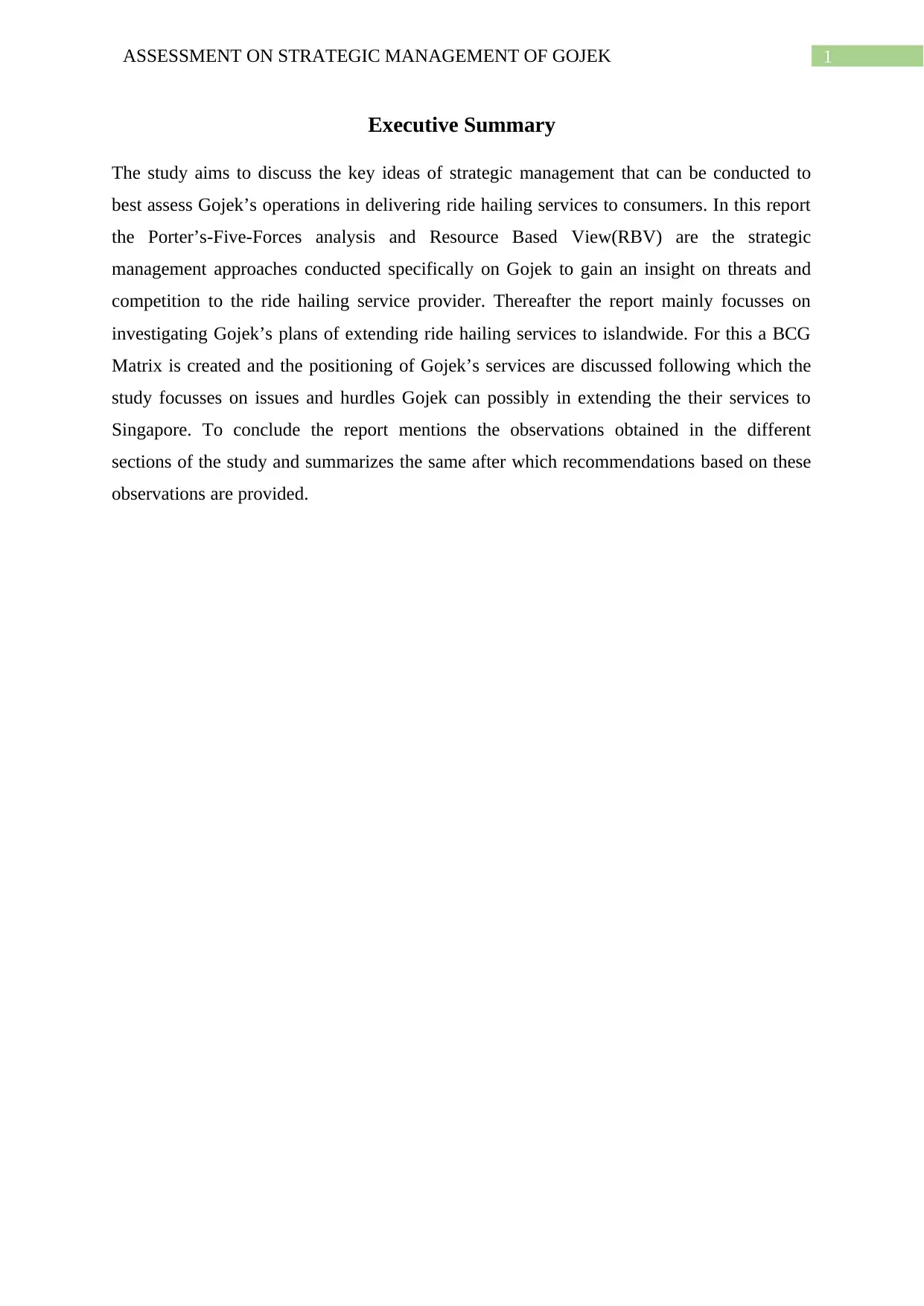
1ASSESSMENT ON STRATEGIC MANAGEMENT OF GOJEK
Executive Summary
The study aims to discuss the key ideas of strategic management that can be conducted to
best assess Gojek’s operations in delivering ride hailing services to consumers. In this report
the Porter’s-Five-Forces analysis and Resource Based View(RBV) are the strategic
management approaches conducted specifically on Gojek to gain an insight on threats and
competition to the ride hailing service provider. Thereafter the report mainly focusses on
investigating Gojek’s plans of extending ride hailing services to islandwide. For this a BCG
Matrix is created and the positioning of Gojek’s services are discussed following which the
study focusses on issues and hurdles Gojek can possibly in extending the their services to
Singapore. To conclude the report mentions the observations obtained in the different
sections of the study and summarizes the same after which recommendations based on these
observations are provided.
Executive Summary
The study aims to discuss the key ideas of strategic management that can be conducted to
best assess Gojek’s operations in delivering ride hailing services to consumers. In this report
the Porter’s-Five-Forces analysis and Resource Based View(RBV) are the strategic
management approaches conducted specifically on Gojek to gain an insight on threats and
competition to the ride hailing service provider. Thereafter the report mainly focusses on
investigating Gojek’s plans of extending ride hailing services to islandwide. For this a BCG
Matrix is created and the positioning of Gojek’s services are discussed following which the
study focusses on issues and hurdles Gojek can possibly in extending the their services to
Singapore. To conclude the report mentions the observations obtained in the different
sections of the study and summarizes the same after which recommendations based on these
observations are provided.
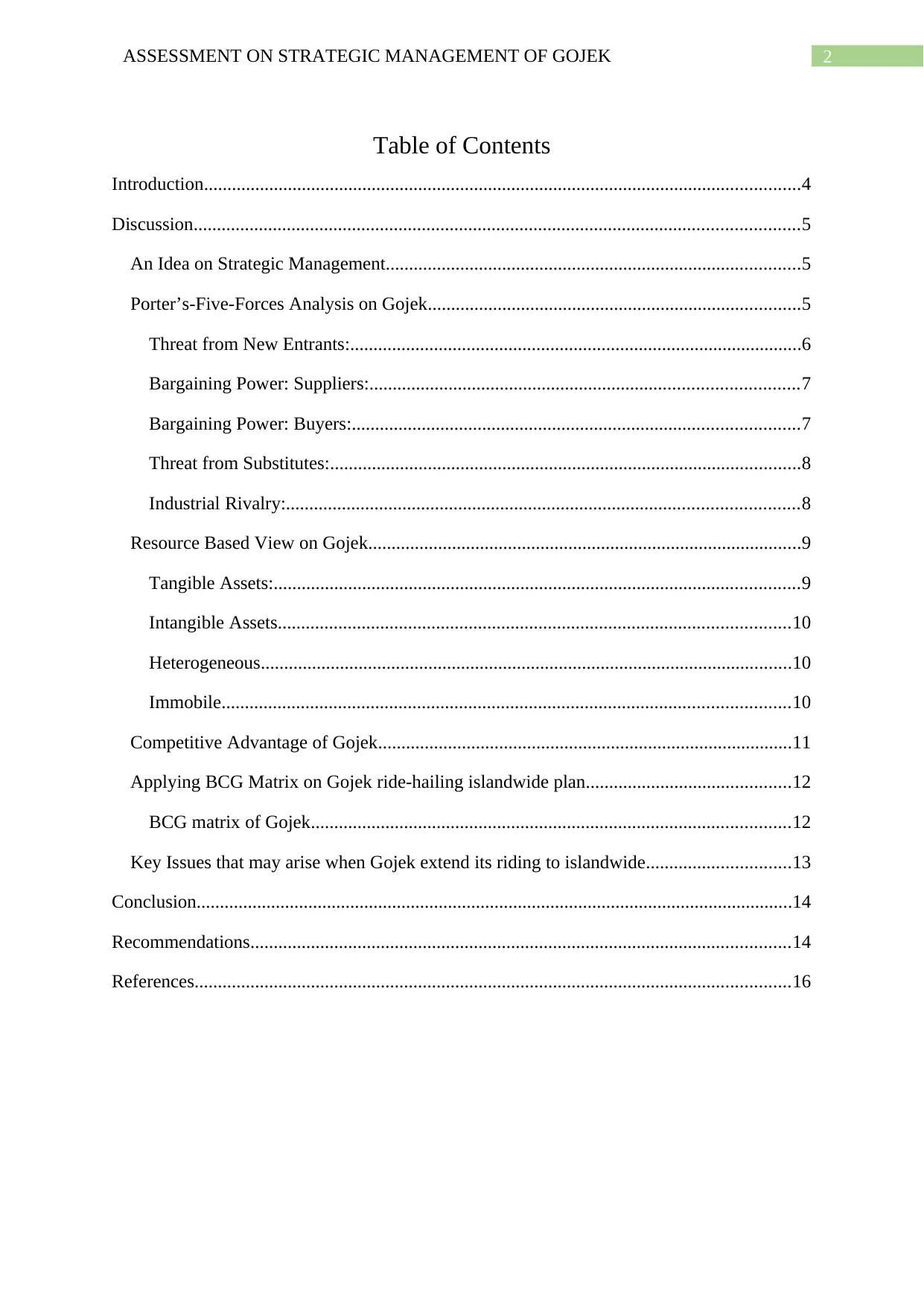
2ASSESSMENT ON STRATEGIC MANAGEMENT OF GOJEK
Table of Contents
Introduction................................................................................................................................4
Discussion..................................................................................................................................5
An Idea on Strategic Management.........................................................................................5
Porter’s-Five-Forces Analysis on Gojek................................................................................5
Threat from New Entrants:.................................................................................................6
Bargaining Power: Suppliers:............................................................................................7
Bargaining Power: Buyers:................................................................................................7
Threat from Substitutes:.....................................................................................................8
Industrial Rivalry:..............................................................................................................8
Resource Based View on Gojek.............................................................................................9
Tangible Assets:.................................................................................................................9
Intangible Assets..............................................................................................................10
Heterogeneous..................................................................................................................10
Immobile..........................................................................................................................10
Competitive Advantage of Gojek.........................................................................................11
Applying BCG Matrix on Gojek ride-hailing islandwide plan............................................12
BCG matrix of Gojek.......................................................................................................12
Key Issues that may arise when Gojek extend its riding to islandwide...............................13
Conclusion................................................................................................................................14
Recommendations....................................................................................................................14
References................................................................................................................................16
Table of Contents
Introduction................................................................................................................................4
Discussion..................................................................................................................................5
An Idea on Strategic Management.........................................................................................5
Porter’s-Five-Forces Analysis on Gojek................................................................................5
Threat from New Entrants:.................................................................................................6
Bargaining Power: Suppliers:............................................................................................7
Bargaining Power: Buyers:................................................................................................7
Threat from Substitutes:.....................................................................................................8
Industrial Rivalry:..............................................................................................................8
Resource Based View on Gojek.............................................................................................9
Tangible Assets:.................................................................................................................9
Intangible Assets..............................................................................................................10
Heterogeneous..................................................................................................................10
Immobile..........................................................................................................................10
Competitive Advantage of Gojek.........................................................................................11
Applying BCG Matrix on Gojek ride-hailing islandwide plan............................................12
BCG matrix of Gojek.......................................................................................................12
Key Issues that may arise when Gojek extend its riding to islandwide...............................13
Conclusion................................................................................................................................14
Recommendations....................................................................................................................14
References................................................................................................................................16
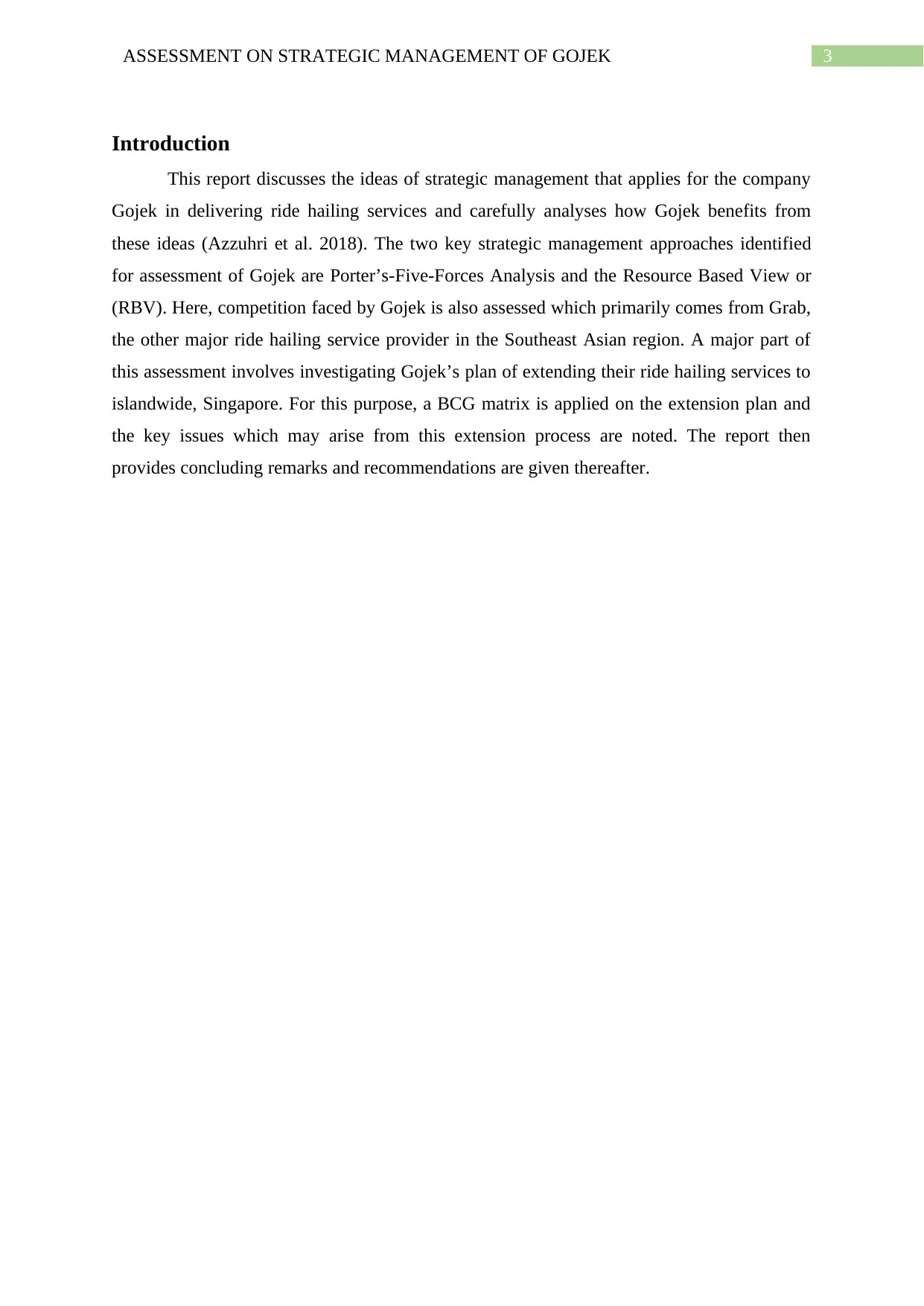
3ASSESSMENT ON STRATEGIC MANAGEMENT OF GOJEK
Introduction
This report discusses the ideas of strategic management that applies for the company
Gojek in delivering ride hailing services and carefully analyses how Gojek benefits from
these ideas (Azzuhri et al. 2018). The two key strategic management approaches identified
for assessment of Gojek are Porter’s-Five-Forces Analysis and the Resource Based View or
(RBV). Here, competition faced by Gojek is also assessed which primarily comes from Grab,
the other major ride hailing service provider in the Southeast Asian region. A major part of
this assessment involves investigating Gojek’s plan of extending their ride hailing services to
islandwide, Singapore. For this purpose, a BCG matrix is applied on the extension plan and
the key issues which may arise from this extension process are noted. The report then
provides concluding remarks and recommendations are given thereafter.
Introduction
This report discusses the ideas of strategic management that applies for the company
Gojek in delivering ride hailing services and carefully analyses how Gojek benefits from
these ideas (Azzuhri et al. 2018). The two key strategic management approaches identified
for assessment of Gojek are Porter’s-Five-Forces Analysis and the Resource Based View or
(RBV). Here, competition faced by Gojek is also assessed which primarily comes from Grab,
the other major ride hailing service provider in the Southeast Asian region. A major part of
this assessment involves investigating Gojek’s plan of extending their ride hailing services to
islandwide, Singapore. For this purpose, a BCG matrix is applied on the extension plan and
the key issues which may arise from this extension process are noted. The report then
provides concluding remarks and recommendations are given thereafter.
Secure Best Marks with AI Grader
Need help grading? Try our AI Grader for instant feedback on your assignments.
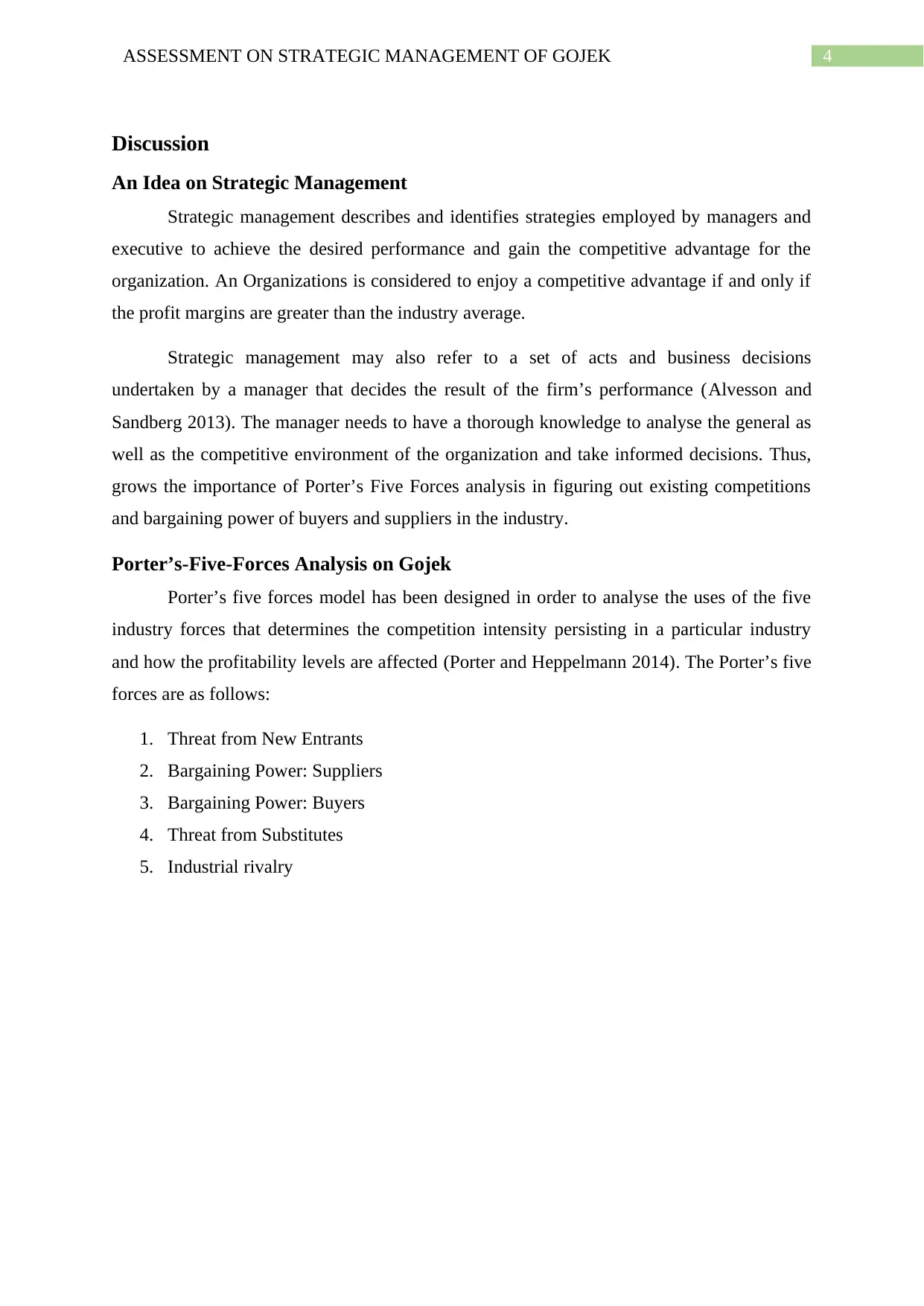
4ASSESSMENT ON STRATEGIC MANAGEMENT OF GOJEK
Discussion
An Idea on Strategic Management
Strategic management describes and identifies strategies employed by managers and
executive to achieve the desired performance and gain the competitive advantage for the
organization. An Organizations is considered to enjoy a competitive advantage if and only if
the profit margins are greater than the industry average.
Strategic management may also refer to a set of acts and business decisions
undertaken by a manager that decides the result of the firm’s performance (Alvesson and
Sandberg 2013). The manager needs to have a thorough knowledge to analyse the general as
well as the competitive environment of the organization and take informed decisions. Thus,
grows the importance of Porter’s Five Forces analysis in figuring out existing competitions
and bargaining power of buyers and suppliers in the industry.
Porter’s-Five-Forces Analysis on Gojek
Porter’s five forces model has been designed in order to analyse the uses of the five
industry forces that determines the competition intensity persisting in a particular industry
and how the profitability levels are affected (Porter and Heppelmann 2014). The Porter’s five
forces are as follows:
1. Threat from New Entrants
2. Bargaining Power: Suppliers
3. Bargaining Power: Buyers
4. Threat from Substitutes
5. Industrial rivalry
Discussion
An Idea on Strategic Management
Strategic management describes and identifies strategies employed by managers and
executive to achieve the desired performance and gain the competitive advantage for the
organization. An Organizations is considered to enjoy a competitive advantage if and only if
the profit margins are greater than the industry average.
Strategic management may also refer to a set of acts and business decisions
undertaken by a manager that decides the result of the firm’s performance (Alvesson and
Sandberg 2013). The manager needs to have a thorough knowledge to analyse the general as
well as the competitive environment of the organization and take informed decisions. Thus,
grows the importance of Porter’s Five Forces analysis in figuring out existing competitions
and bargaining power of buyers and suppliers in the industry.
Porter’s-Five-Forces Analysis on Gojek
Porter’s five forces model has been designed in order to analyse the uses of the five
industry forces that determines the competition intensity persisting in a particular industry
and how the profitability levels are affected (Porter and Heppelmann 2014). The Porter’s five
forces are as follows:
1. Threat from New Entrants
2. Bargaining Power: Suppliers
3. Bargaining Power: Buyers
4. Threat from Substitutes
5. Industrial rivalry
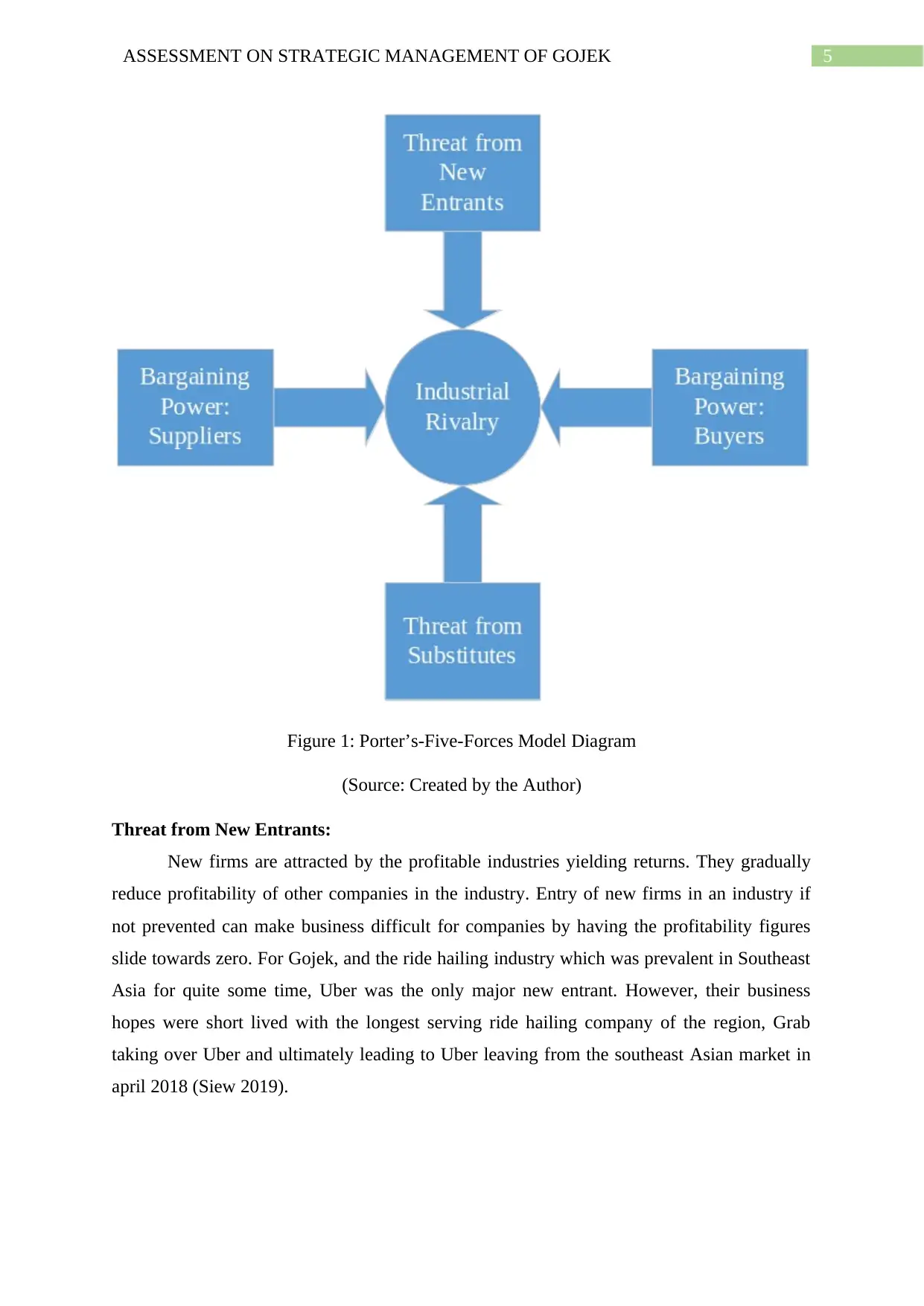
5ASSESSMENT ON STRATEGIC MANAGEMENT OF GOJEK
Figure 1: Porter’s-Five-Forces Model Diagram
(Source: Created by the Author)
Threat from New Entrants:
New firms are attracted by the profitable industries yielding returns. They gradually
reduce profitability of other companies in the industry. Entry of new firms in an industry if
not prevented can make business difficult for companies by having the profitability figures
slide towards zero. For Gojek, and the ride hailing industry which was prevalent in Southeast
Asia for quite some time, Uber was the only major new entrant. However, their business
hopes were short lived with the longest serving ride hailing company of the region, Grab
taking over Uber and ultimately leading to Uber leaving from the southeast Asian market in
april 2018 (Siew 2019).
Figure 1: Porter’s-Five-Forces Model Diagram
(Source: Created by the Author)
Threat from New Entrants:
New firms are attracted by the profitable industries yielding returns. They gradually
reduce profitability of other companies in the industry. Entry of new firms in an industry if
not prevented can make business difficult for companies by having the profitability figures
slide towards zero. For Gojek, and the ride hailing industry which was prevalent in Southeast
Asia for quite some time, Uber was the only major new entrant. However, their business
hopes were short lived with the longest serving ride hailing company of the region, Grab
taking over Uber and ultimately leading to Uber leaving from the southeast Asian market in
april 2018 (Siew 2019).
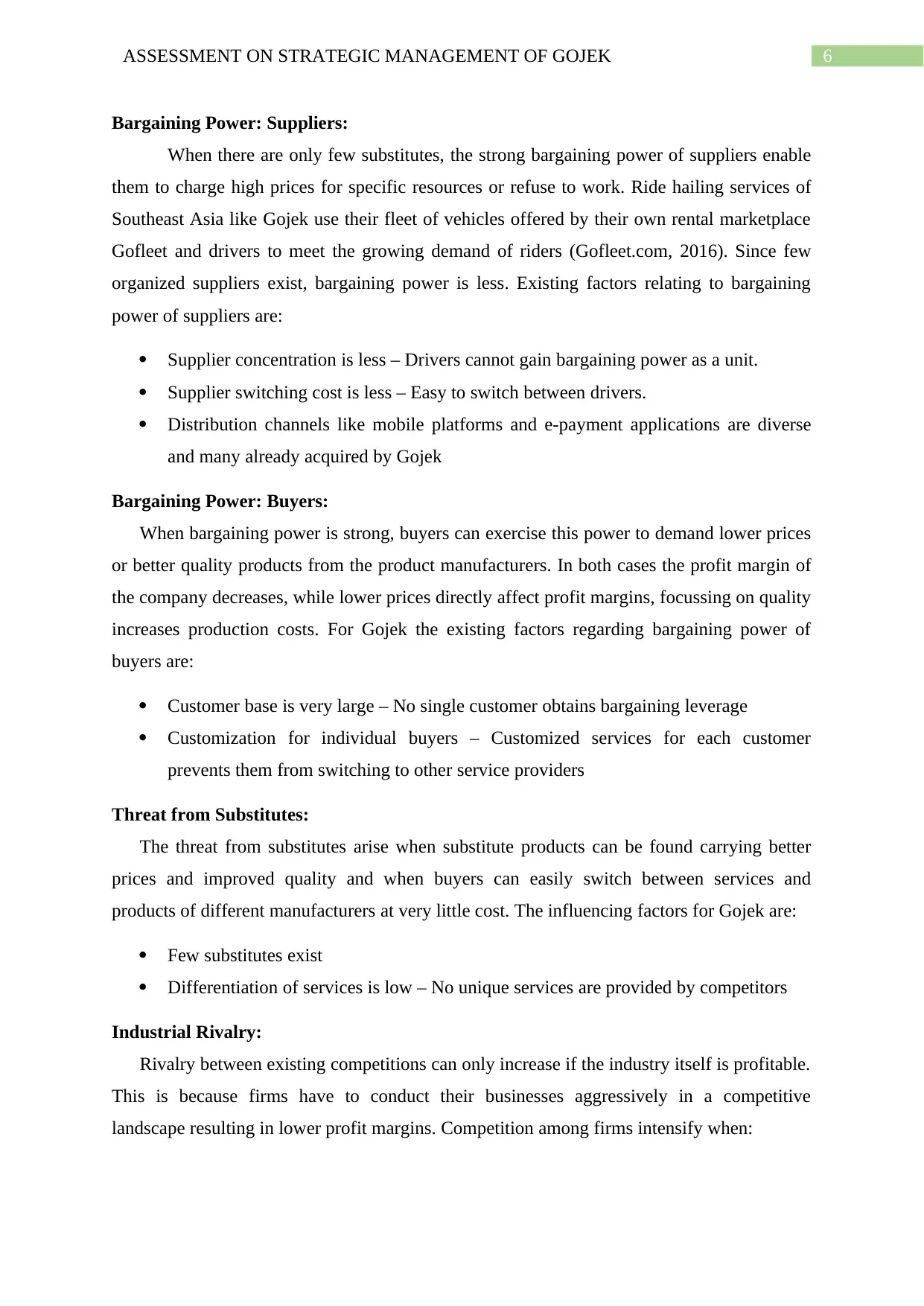
6ASSESSMENT ON STRATEGIC MANAGEMENT OF GOJEK
Bargaining Power: Suppliers:
When there are only few substitutes, the strong bargaining power of suppliers enable
them to charge high prices for specific resources or refuse to work. Ride hailing services of
Southeast Asia like Gojek use their fleet of vehicles offered by their own rental marketplace
Gofleet and drivers to meet the growing demand of riders (Gofleet.com, 2016). Since few
organized suppliers exist, bargaining power is less. Existing factors relating to bargaining
power of suppliers are:
Supplier concentration is less – Drivers cannot gain bargaining power as a unit.
Supplier switching cost is less – Easy to switch between drivers.
Distribution channels like mobile platforms and e-payment applications are diverse
and many already acquired by Gojek
Bargaining Power: Buyers:
When bargaining power is strong, buyers can exercise this power to demand lower prices
or better quality products from the product manufacturers. In both cases the profit margin of
the company decreases, while lower prices directly affect profit margins, focussing on quality
increases production costs. For Gojek the existing factors regarding bargaining power of
buyers are:
Customer base is very large – No single customer obtains bargaining leverage
Customization for individual buyers – Customized services for each customer
prevents them from switching to other service providers
Threat from Substitutes:
The threat from substitutes arise when substitute products can be found carrying better
prices and improved quality and when buyers can easily switch between services and
products of different manufacturers at very little cost. The influencing factors for Gojek are:
Few substitutes exist
Differentiation of services is low – No unique services are provided by competitors
Industrial Rivalry:
Rivalry between existing competitions can only increase if the industry itself is profitable.
This is because firms have to conduct their businesses aggressively in a competitive
landscape resulting in lower profit margins. Competition among firms intensify when:
Bargaining Power: Suppliers:
When there are only few substitutes, the strong bargaining power of suppliers enable
them to charge high prices for specific resources or refuse to work. Ride hailing services of
Southeast Asia like Gojek use their fleet of vehicles offered by their own rental marketplace
Gofleet and drivers to meet the growing demand of riders (Gofleet.com, 2016). Since few
organized suppliers exist, bargaining power is less. Existing factors relating to bargaining
power of suppliers are:
Supplier concentration is less – Drivers cannot gain bargaining power as a unit.
Supplier switching cost is less – Easy to switch between drivers.
Distribution channels like mobile platforms and e-payment applications are diverse
and many already acquired by Gojek
Bargaining Power: Buyers:
When bargaining power is strong, buyers can exercise this power to demand lower prices
or better quality products from the product manufacturers. In both cases the profit margin of
the company decreases, while lower prices directly affect profit margins, focussing on quality
increases production costs. For Gojek the existing factors regarding bargaining power of
buyers are:
Customer base is very large – No single customer obtains bargaining leverage
Customization for individual buyers – Customized services for each customer
prevents them from switching to other service providers
Threat from Substitutes:
The threat from substitutes arise when substitute products can be found carrying better
prices and improved quality and when buyers can easily switch between services and
products of different manufacturers at very little cost. The influencing factors for Gojek are:
Few substitutes exist
Differentiation of services is low – No unique services are provided by competitors
Industrial Rivalry:
Rivalry between existing competitions can only increase if the industry itself is profitable.
This is because firms have to conduct their businesses aggressively in a competitive
landscape resulting in lower profit margins. Competition among firms intensify when:
Paraphrase This Document
Need a fresh take? Get an instant paraphrase of this document with our AI Paraphraser
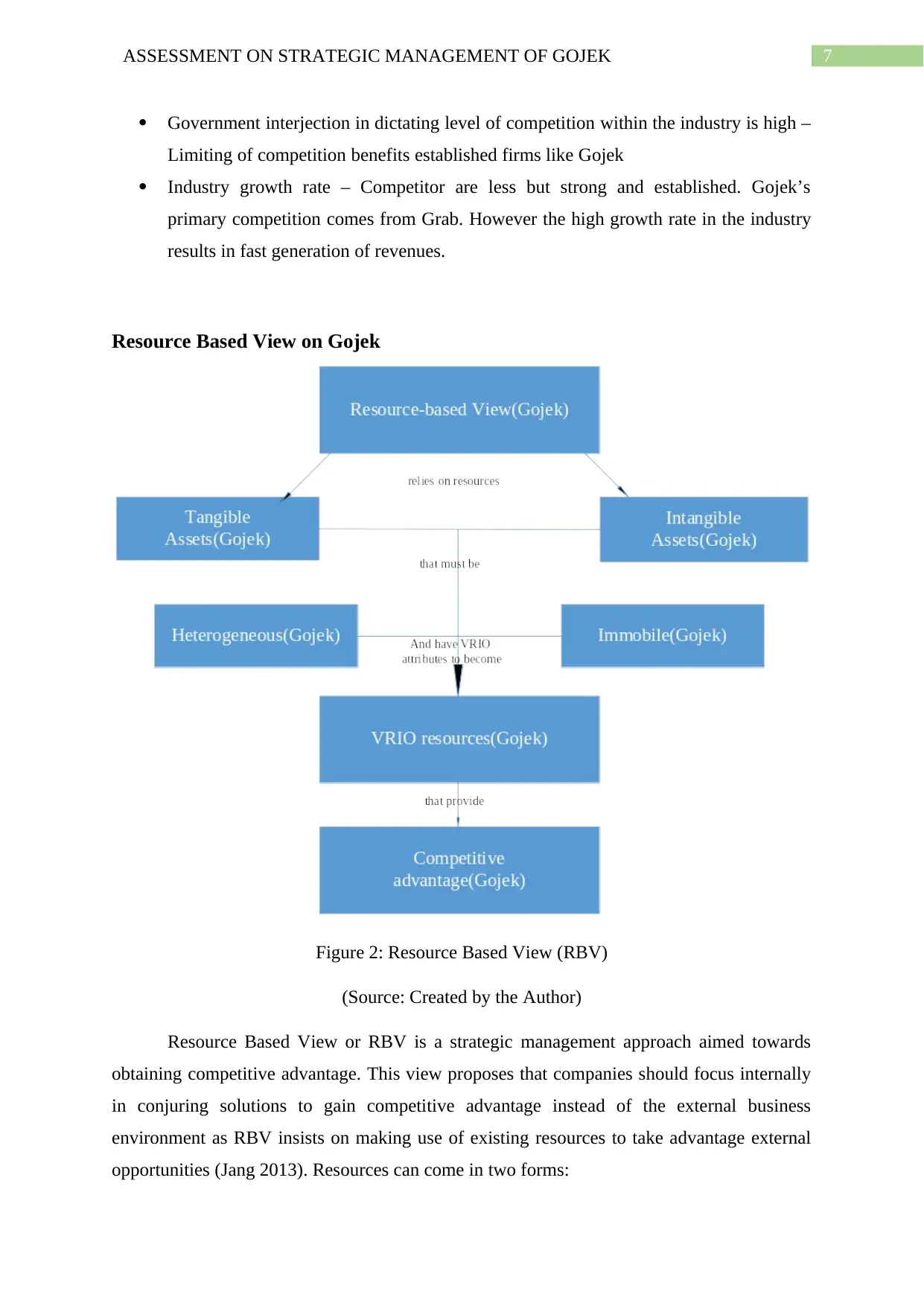
7ASSESSMENT ON STRATEGIC MANAGEMENT OF GOJEK
Government interjection in dictating level of competition within the industry is high –
Limiting of competition benefits established firms like Gojek
Industry growth rate – Competitor are less but strong and established. Gojek’s
primary competition comes from Grab. However the high growth rate in the industry
results in fast generation of revenues.
Resource Based View on Gojek
Figure 2: Resource Based View (RBV)
(Source: Created by the Author)
Resource Based View or RBV is a strategic management approach aimed towards
obtaining competitive advantage. This view proposes that companies should focus internally
in conjuring solutions to gain competitive advantage instead of the external business
environment as RBV insists on making use of existing resources to take advantage external
opportunities (Jang 2013). Resources can come in two forms:
Government interjection in dictating level of competition within the industry is high –
Limiting of competition benefits established firms like Gojek
Industry growth rate – Competitor are less but strong and established. Gojek’s
primary competition comes from Grab. However the high growth rate in the industry
results in fast generation of revenues.
Resource Based View on Gojek
Figure 2: Resource Based View (RBV)
(Source: Created by the Author)
Resource Based View or RBV is a strategic management approach aimed towards
obtaining competitive advantage. This view proposes that companies should focus internally
in conjuring solutions to gain competitive advantage instead of the external business
environment as RBV insists on making use of existing resources to take advantage external
opportunities (Jang 2013). Resources can come in two forms:
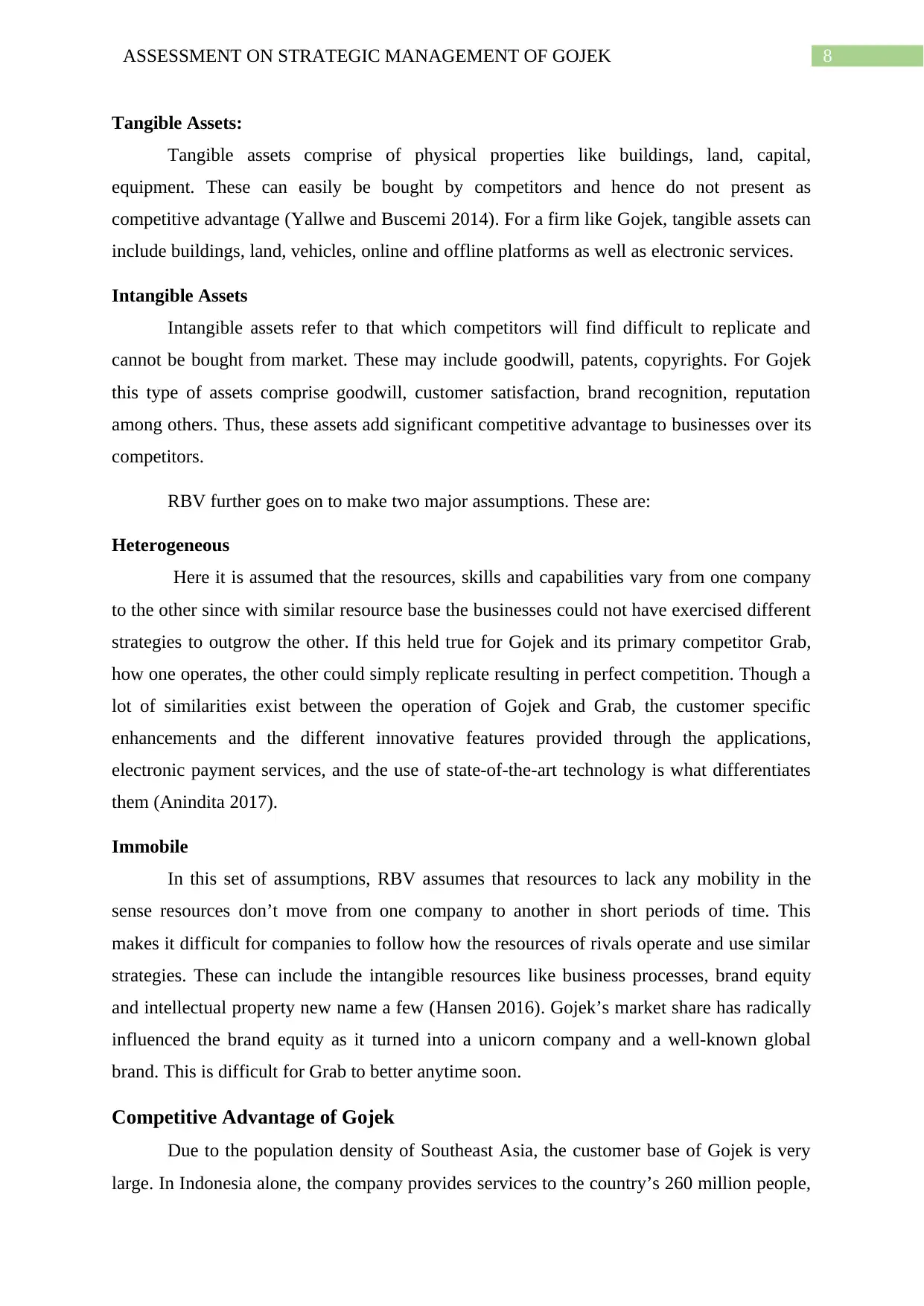
8ASSESSMENT ON STRATEGIC MANAGEMENT OF GOJEK
Tangible Assets:
Tangible assets comprise of physical properties like buildings, land, capital,
equipment. These can easily be bought by competitors and hence do not present as
competitive advantage (Yallwe and Buscemi 2014). For a firm like Gojek, tangible assets can
include buildings, land, vehicles, online and offline platforms as well as electronic services.
Intangible Assets
Intangible assets refer to that which competitors will find difficult to replicate and
cannot be bought from market. These may include goodwill, patents, copyrights. For Gojek
this type of assets comprise goodwill, customer satisfaction, brand recognition, reputation
among others. Thus, these assets add significant competitive advantage to businesses over its
competitors.
RBV further goes on to make two major assumptions. These are:
Heterogeneous
Here it is assumed that the resources, skills and capabilities vary from one company
to the other since with similar resource base the businesses could not have exercised different
strategies to outgrow the other. If this held true for Gojek and its primary competitor Grab,
how one operates, the other could simply replicate resulting in perfect competition. Though a
lot of similarities exist between the operation of Gojek and Grab, the customer specific
enhancements and the different innovative features provided through the applications,
electronic payment services, and the use of state-of-the-art technology is what differentiates
them (Anindita 2017).
Immobile
In this set of assumptions, RBV assumes that resources to lack any mobility in the
sense resources don’t move from one company to another in short periods of time. This
makes it difficult for companies to follow how the resources of rivals operate and use similar
strategies. These can include the intangible resources like business processes, brand equity
and intellectual property new name a few (Hansen 2016). Gojek’s market share has radically
influenced the brand equity as it turned into a unicorn company and a well-known global
brand. This is difficult for Grab to better anytime soon.
Competitive Advantage of Gojek
Due to the population density of Southeast Asia, the customer base of Gojek is very
large. In Indonesia alone, the company provides services to the country’s 260 million people,
Tangible Assets:
Tangible assets comprise of physical properties like buildings, land, capital,
equipment. These can easily be bought by competitors and hence do not present as
competitive advantage (Yallwe and Buscemi 2014). For a firm like Gojek, tangible assets can
include buildings, land, vehicles, online and offline platforms as well as electronic services.
Intangible Assets
Intangible assets refer to that which competitors will find difficult to replicate and
cannot be bought from market. These may include goodwill, patents, copyrights. For Gojek
this type of assets comprise goodwill, customer satisfaction, brand recognition, reputation
among others. Thus, these assets add significant competitive advantage to businesses over its
competitors.
RBV further goes on to make two major assumptions. These are:
Heterogeneous
Here it is assumed that the resources, skills and capabilities vary from one company
to the other since with similar resource base the businesses could not have exercised different
strategies to outgrow the other. If this held true for Gojek and its primary competitor Grab,
how one operates, the other could simply replicate resulting in perfect competition. Though a
lot of similarities exist between the operation of Gojek and Grab, the customer specific
enhancements and the different innovative features provided through the applications,
electronic payment services, and the use of state-of-the-art technology is what differentiates
them (Anindita 2017).
Immobile
In this set of assumptions, RBV assumes that resources to lack any mobility in the
sense resources don’t move from one company to another in short periods of time. This
makes it difficult for companies to follow how the resources of rivals operate and use similar
strategies. These can include the intangible resources like business processes, brand equity
and intellectual property new name a few (Hansen 2016). Gojek’s market share has radically
influenced the brand equity as it turned into a unicorn company and a well-known global
brand. This is difficult for Grab to better anytime soon.
Competitive Advantage of Gojek
Due to the population density of Southeast Asia, the customer base of Gojek is very
large. In Indonesia alone, the company provides services to the country’s 260 million people,
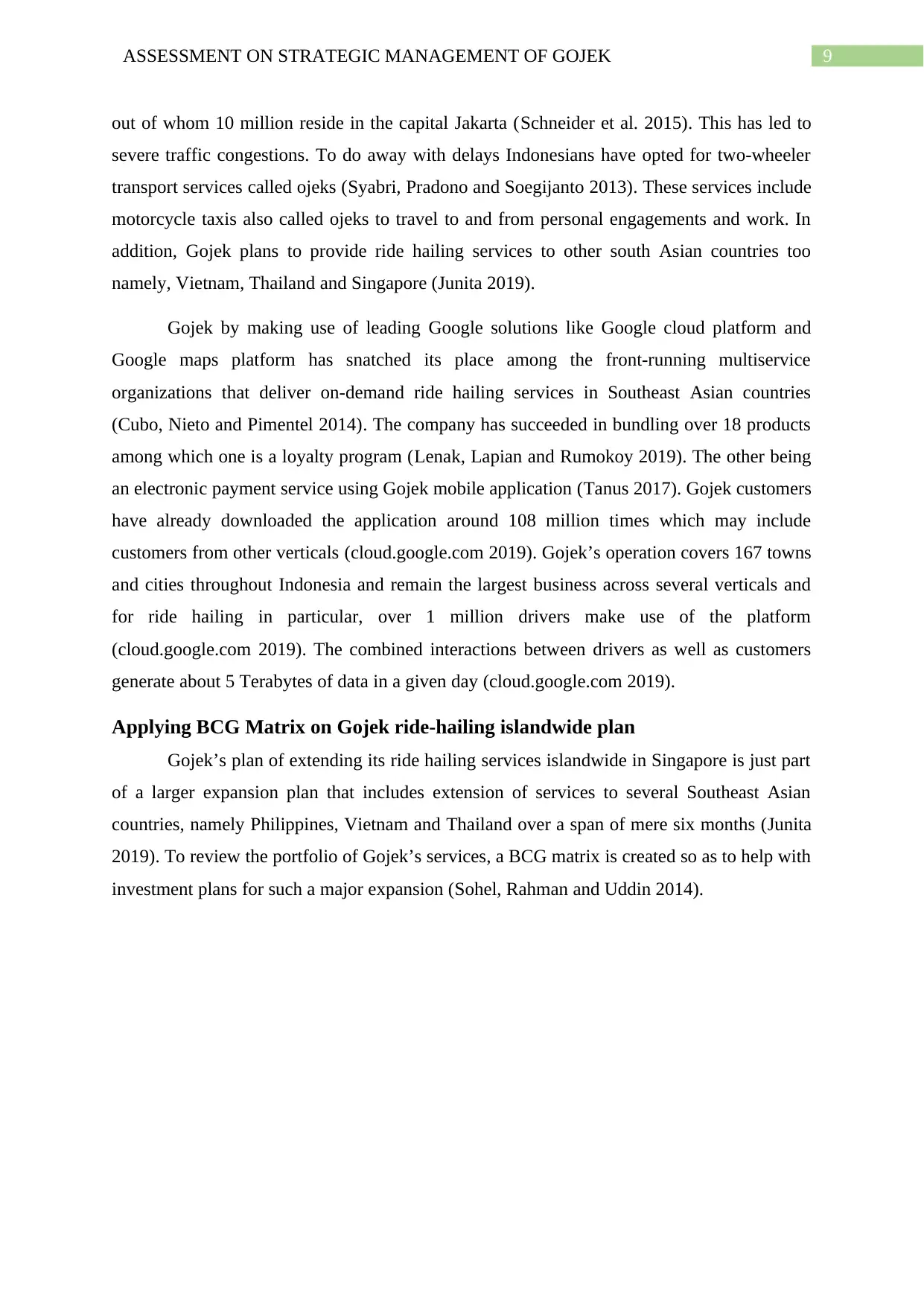
9ASSESSMENT ON STRATEGIC MANAGEMENT OF GOJEK
out of whom 10 million reside in the capital Jakarta (Schneider et al. 2015). This has led to
severe traffic congestions. To do away with delays Indonesians have opted for two-wheeler
transport services called ojeks (Syabri, Pradono and Soegijanto 2013). These services include
motorcycle taxis also called ojeks to travel to and from personal engagements and work. In
addition, Gojek plans to provide ride hailing services to other south Asian countries too
namely, Vietnam, Thailand and Singapore (Junita 2019).
Gojek by making use of leading Google solutions like Google cloud platform and
Google maps platform has snatched its place among the front-running multiservice
organizations that deliver on-demand ride hailing services in Southeast Asian countries
(Cubo, Nieto and Pimentel 2014). The company has succeeded in bundling over 18 products
among which one is a loyalty program (Lenak, Lapian and Rumokoy 2019). The other being
an electronic payment service using Gojek mobile application (Tanus 2017). Gojek customers
have already downloaded the application around 108 million times which may include
customers from other verticals (cloud.google.com 2019). Gojek’s operation covers 167 towns
and cities throughout Indonesia and remain the largest business across several verticals and
for ride hailing in particular, over 1 million drivers make use of the platform
(cloud.google.com 2019). The combined interactions between drivers as well as customers
generate about 5 Terabytes of data in a given day (cloud.google.com 2019).
Applying BCG Matrix on Gojek ride-hailing islandwide plan
Gojek’s plan of extending its ride hailing services islandwide in Singapore is just part
of a larger expansion plan that includes extension of services to several Southeast Asian
countries, namely Philippines, Vietnam and Thailand over a span of mere six months (Junita
2019). To review the portfolio of Gojek’s services, a BCG matrix is created so as to help with
investment plans for such a major expansion (Sohel, Rahman and Uddin 2014).
out of whom 10 million reside in the capital Jakarta (Schneider et al. 2015). This has led to
severe traffic congestions. To do away with delays Indonesians have opted for two-wheeler
transport services called ojeks (Syabri, Pradono and Soegijanto 2013). These services include
motorcycle taxis also called ojeks to travel to and from personal engagements and work. In
addition, Gojek plans to provide ride hailing services to other south Asian countries too
namely, Vietnam, Thailand and Singapore (Junita 2019).
Gojek by making use of leading Google solutions like Google cloud platform and
Google maps platform has snatched its place among the front-running multiservice
organizations that deliver on-demand ride hailing services in Southeast Asian countries
(Cubo, Nieto and Pimentel 2014). The company has succeeded in bundling over 18 products
among which one is a loyalty program (Lenak, Lapian and Rumokoy 2019). The other being
an electronic payment service using Gojek mobile application (Tanus 2017). Gojek customers
have already downloaded the application around 108 million times which may include
customers from other verticals (cloud.google.com 2019). Gojek’s operation covers 167 towns
and cities throughout Indonesia and remain the largest business across several verticals and
for ride hailing in particular, over 1 million drivers make use of the platform
(cloud.google.com 2019). The combined interactions between drivers as well as customers
generate about 5 Terabytes of data in a given day (cloud.google.com 2019).
Applying BCG Matrix on Gojek ride-hailing islandwide plan
Gojek’s plan of extending its ride hailing services islandwide in Singapore is just part
of a larger expansion plan that includes extension of services to several Southeast Asian
countries, namely Philippines, Vietnam and Thailand over a span of mere six months (Junita
2019). To review the portfolio of Gojek’s services, a BCG matrix is created so as to help with
investment plans for such a major expansion (Sohel, Rahman and Uddin 2014).
Secure Best Marks with AI Grader
Need help grading? Try our AI Grader for instant feedback on your assignments.
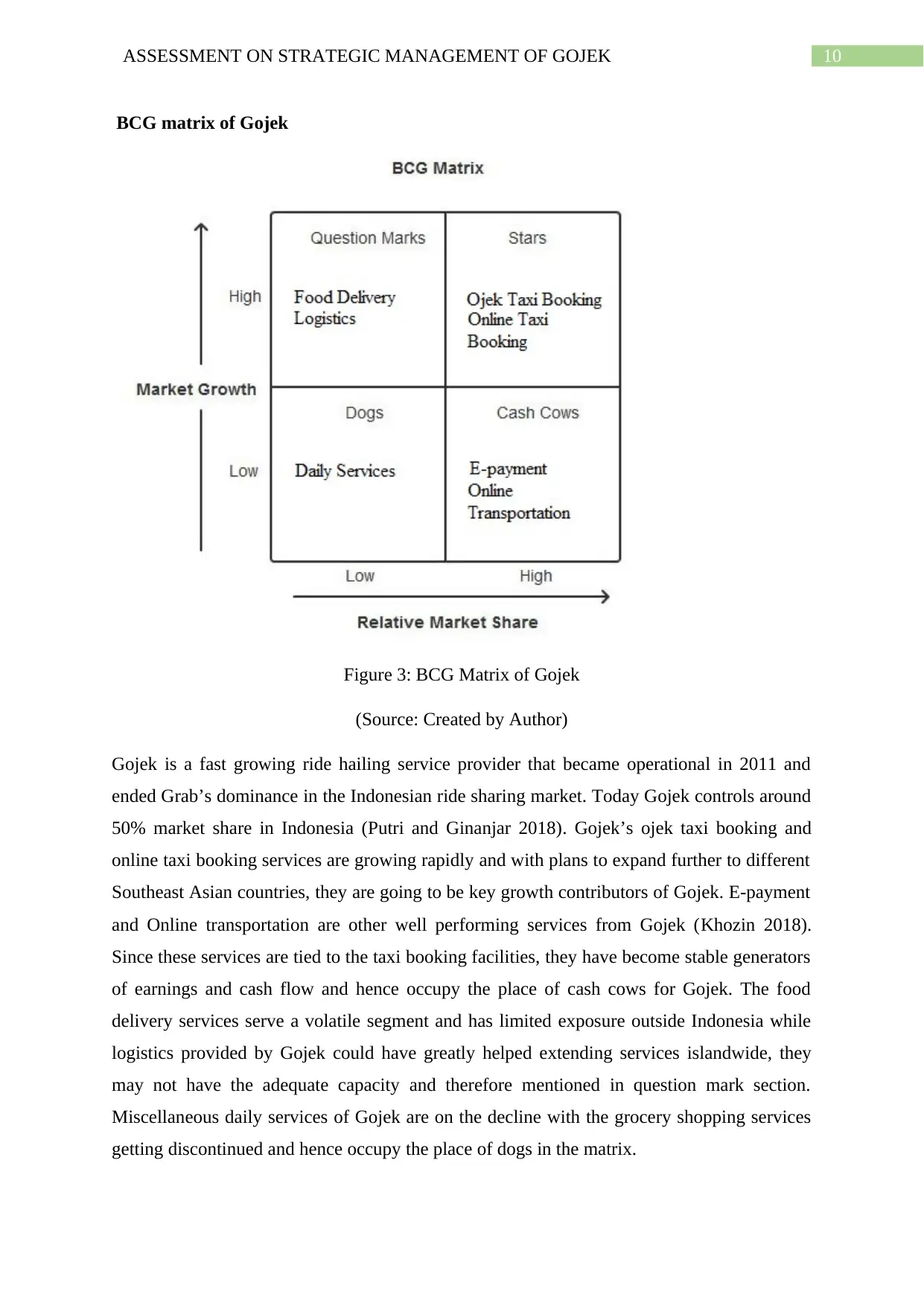
10ASSESSMENT ON STRATEGIC MANAGEMENT OF GOJEK
BCG matrix of Gojek
Figure 3: BCG Matrix of Gojek
(Source: Created by Author)
Gojek is a fast growing ride hailing service provider that became operational in 2011 and
ended Grab’s dominance in the Indonesian ride sharing market. Today Gojek controls around
50% market share in Indonesia (Putri and Ginanjar 2018). Gojek’s ojek taxi booking and
online taxi booking services are growing rapidly and with plans to expand further to different
Southeast Asian countries, they are going to be key growth contributors of Gojek. E-payment
and Online transportation are other well performing services from Gojek (Khozin 2018).
Since these services are tied to the taxi booking facilities, they have become stable generators
of earnings and cash flow and hence occupy the place of cash cows for Gojek. The food
delivery services serve a volatile segment and has limited exposure outside Indonesia while
logistics provided by Gojek could have greatly helped extending services islandwide, they
may not have the adequate capacity and therefore mentioned in question mark section.
Miscellaneous daily services of Gojek are on the decline with the grocery shopping services
getting discontinued and hence occupy the place of dogs in the matrix.
BCG matrix of Gojek
Figure 3: BCG Matrix of Gojek
(Source: Created by Author)
Gojek is a fast growing ride hailing service provider that became operational in 2011 and
ended Grab’s dominance in the Indonesian ride sharing market. Today Gojek controls around
50% market share in Indonesia (Putri and Ginanjar 2018). Gojek’s ojek taxi booking and
online taxi booking services are growing rapidly and with plans to expand further to different
Southeast Asian countries, they are going to be key growth contributors of Gojek. E-payment
and Online transportation are other well performing services from Gojek (Khozin 2018).
Since these services are tied to the taxi booking facilities, they have become stable generators
of earnings and cash flow and hence occupy the place of cash cows for Gojek. The food
delivery services serve a volatile segment and has limited exposure outside Indonesia while
logistics provided by Gojek could have greatly helped extending services islandwide, they
may not have the adequate capacity and therefore mentioned in question mark section.
Miscellaneous daily services of Gojek are on the decline with the grocery shopping services
getting discontinued and hence occupy the place of dogs in the matrix.
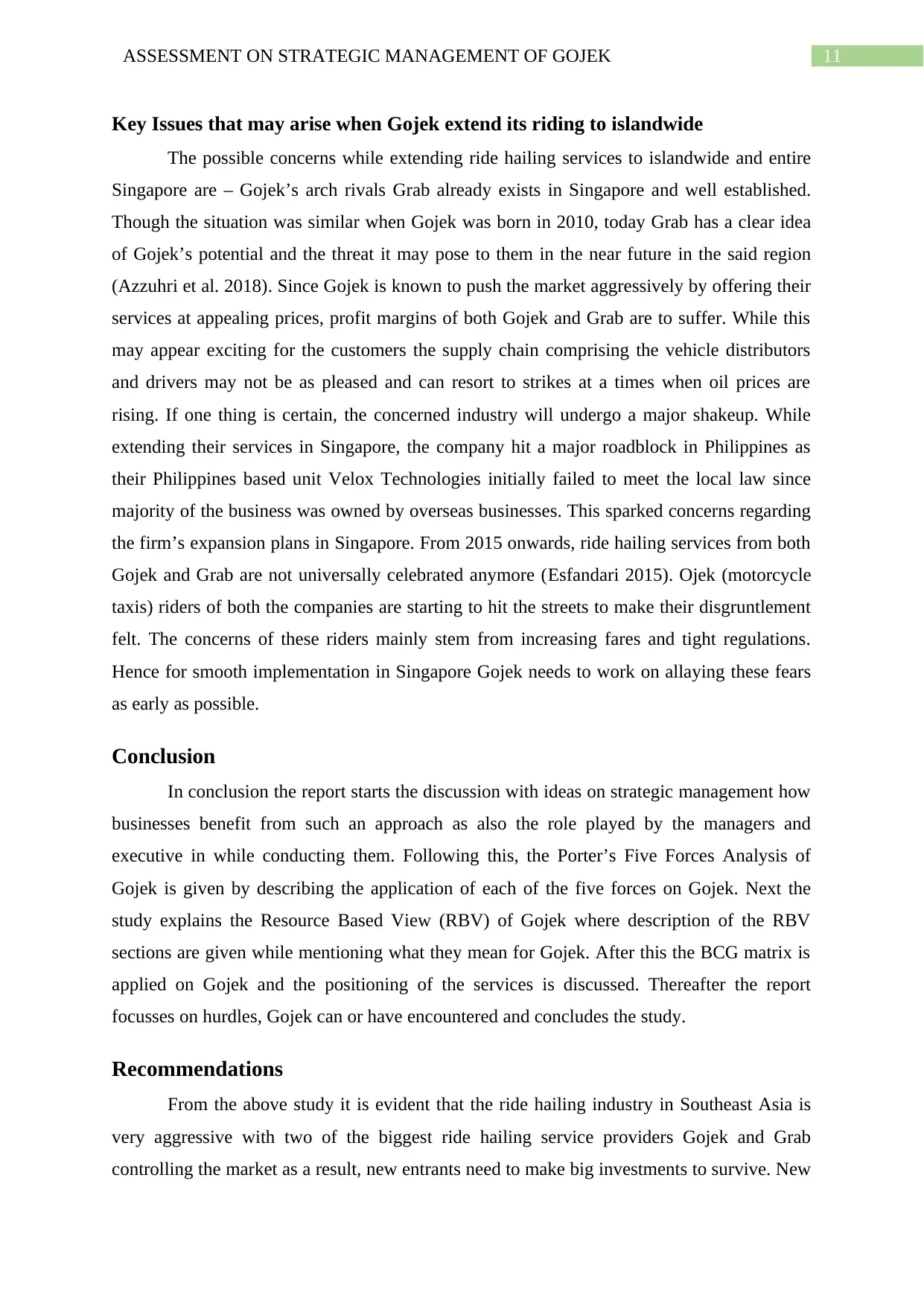
11ASSESSMENT ON STRATEGIC MANAGEMENT OF GOJEK
Key Issues that may arise when Gojek extend its riding to islandwide
The possible concerns while extending ride hailing services to islandwide and entire
Singapore are – Gojek’s arch rivals Grab already exists in Singapore and well established.
Though the situation was similar when Gojek was born in 2010, today Grab has a clear idea
of Gojek’s potential and the threat it may pose to them in the near future in the said region
(Azzuhri et al. 2018). Since Gojek is known to push the market aggressively by offering their
services at appealing prices, profit margins of both Gojek and Grab are to suffer. While this
may appear exciting for the customers the supply chain comprising the vehicle distributors
and drivers may not be as pleased and can resort to strikes at a times when oil prices are
rising. If one thing is certain, the concerned industry will undergo a major shakeup. While
extending their services in Singapore, the company hit a major roadblock in Philippines as
their Philippines based unit Velox Technologies initially failed to meet the local law since
majority of the business was owned by overseas businesses. This sparked concerns regarding
the firm’s expansion plans in Singapore. From 2015 onwards, ride hailing services from both
Gojek and Grab are not universally celebrated anymore (Esfandari 2015). Ojek (motorcycle
taxis) riders of both the companies are starting to hit the streets to make their disgruntlement
felt. The concerns of these riders mainly stem from increasing fares and tight regulations.
Hence for smooth implementation in Singapore Gojek needs to work on allaying these fears
as early as possible.
Conclusion
In conclusion the report starts the discussion with ideas on strategic management how
businesses benefit from such an approach as also the role played by the managers and
executive in while conducting them. Following this, the Porter’s Five Forces Analysis of
Gojek is given by describing the application of each of the five forces on Gojek. Next the
study explains the Resource Based View (RBV) of Gojek where description of the RBV
sections are given while mentioning what they mean for Gojek. After this the BCG matrix is
applied on Gojek and the positioning of the services is discussed. Thereafter the report
focusses on hurdles, Gojek can or have encountered and concludes the study.
Recommendations
From the above study it is evident that the ride hailing industry in Southeast Asia is
very aggressive with two of the biggest ride hailing service providers Gojek and Grab
controlling the market as a result, new entrants need to make big investments to survive. New
Key Issues that may arise when Gojek extend its riding to islandwide
The possible concerns while extending ride hailing services to islandwide and entire
Singapore are – Gojek’s arch rivals Grab already exists in Singapore and well established.
Though the situation was similar when Gojek was born in 2010, today Grab has a clear idea
of Gojek’s potential and the threat it may pose to them in the near future in the said region
(Azzuhri et al. 2018). Since Gojek is known to push the market aggressively by offering their
services at appealing prices, profit margins of both Gojek and Grab are to suffer. While this
may appear exciting for the customers the supply chain comprising the vehicle distributors
and drivers may not be as pleased and can resort to strikes at a times when oil prices are
rising. If one thing is certain, the concerned industry will undergo a major shakeup. While
extending their services in Singapore, the company hit a major roadblock in Philippines as
their Philippines based unit Velox Technologies initially failed to meet the local law since
majority of the business was owned by overseas businesses. This sparked concerns regarding
the firm’s expansion plans in Singapore. From 2015 onwards, ride hailing services from both
Gojek and Grab are not universally celebrated anymore (Esfandari 2015). Ojek (motorcycle
taxis) riders of both the companies are starting to hit the streets to make their disgruntlement
felt. The concerns of these riders mainly stem from increasing fares and tight regulations.
Hence for smooth implementation in Singapore Gojek needs to work on allaying these fears
as early as possible.
Conclusion
In conclusion the report starts the discussion with ideas on strategic management how
businesses benefit from such an approach as also the role played by the managers and
executive in while conducting them. Following this, the Porter’s Five Forces Analysis of
Gojek is given by describing the application of each of the five forces on Gojek. Next the
study explains the Resource Based View (RBV) of Gojek where description of the RBV
sections are given while mentioning what they mean for Gojek. After this the BCG matrix is
applied on Gojek and the positioning of the services is discussed. Thereafter the report
focusses on hurdles, Gojek can or have encountered and concludes the study.
Recommendations
From the above study it is evident that the ride hailing industry in Southeast Asia is
very aggressive with two of the biggest ride hailing service providers Gojek and Grab
controlling the market as a result, new entrants need to make big investments to survive. New
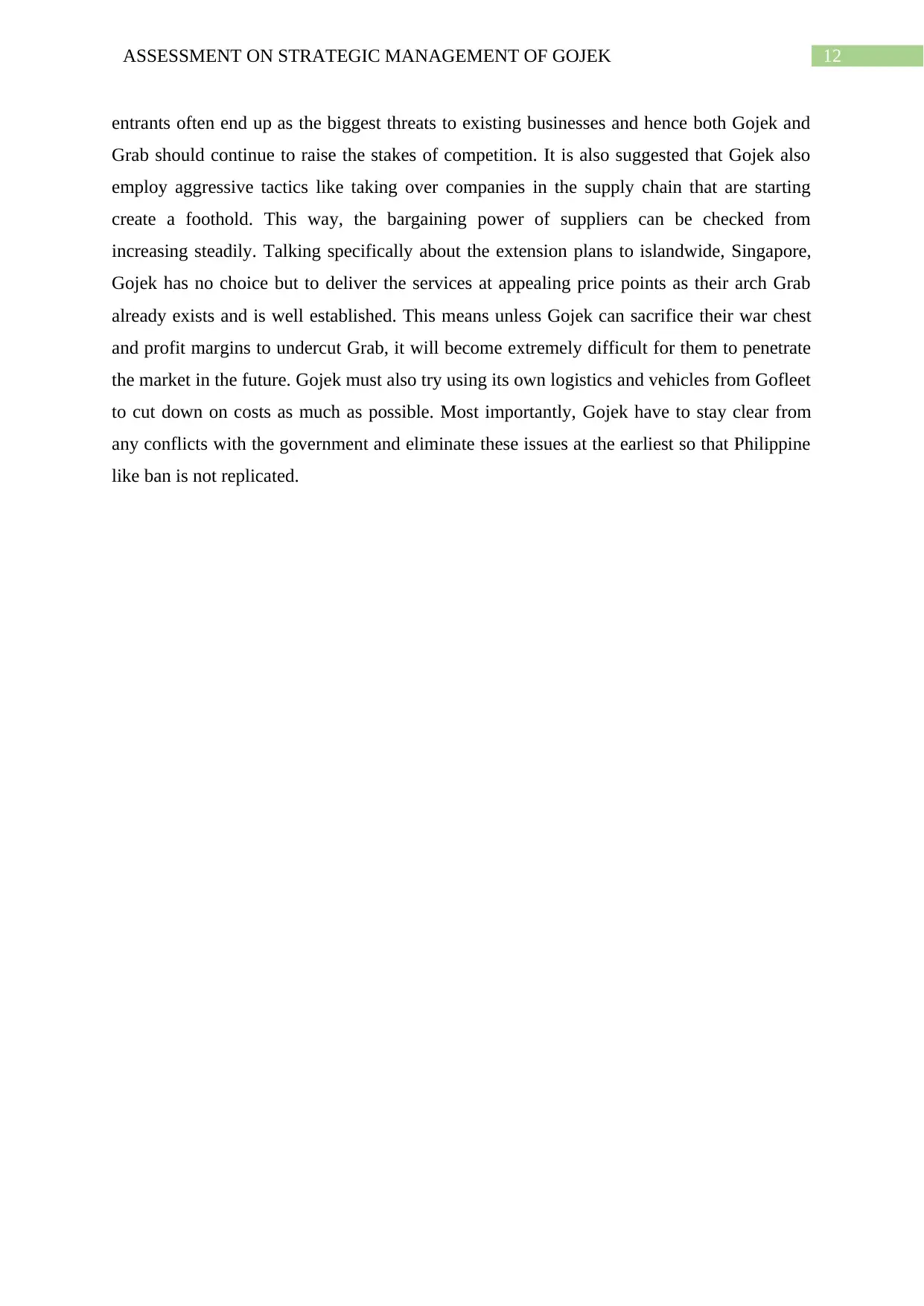
12ASSESSMENT ON STRATEGIC MANAGEMENT OF GOJEK
entrants often end up as the biggest threats to existing businesses and hence both Gojek and
Grab should continue to raise the stakes of competition. It is also suggested that Gojek also
employ aggressive tactics like taking over companies in the supply chain that are starting
create a foothold. This way, the bargaining power of suppliers can be checked from
increasing steadily. Talking specifically about the extension plans to islandwide, Singapore,
Gojek has no choice but to deliver the services at appealing price points as their arch Grab
already exists and is well established. This means unless Gojek can sacrifice their war chest
and profit margins to undercut Grab, it will become extremely difficult for them to penetrate
the market in the future. Gojek must also try using its own logistics and vehicles from Gofleet
to cut down on costs as much as possible. Most importantly, Gojek have to stay clear from
any conflicts with the government and eliminate these issues at the earliest so that Philippine
like ban is not replicated.
entrants often end up as the biggest threats to existing businesses and hence both Gojek and
Grab should continue to raise the stakes of competition. It is also suggested that Gojek also
employ aggressive tactics like taking over companies in the supply chain that are starting
create a foothold. This way, the bargaining power of suppliers can be checked from
increasing steadily. Talking specifically about the extension plans to islandwide, Singapore,
Gojek has no choice but to deliver the services at appealing price points as their arch Grab
already exists and is well established. This means unless Gojek can sacrifice their war chest
and profit margins to undercut Grab, it will become extremely difficult for them to penetrate
the market in the future. Gojek must also try using its own logistics and vehicles from Gofleet
to cut down on costs as much as possible. Most importantly, Gojek have to stay clear from
any conflicts with the government and eliminate these issues at the earliest so that Philippine
like ban is not replicated.
Paraphrase This Document
Need a fresh take? Get an instant paraphrase of this document with our AI Paraphraser
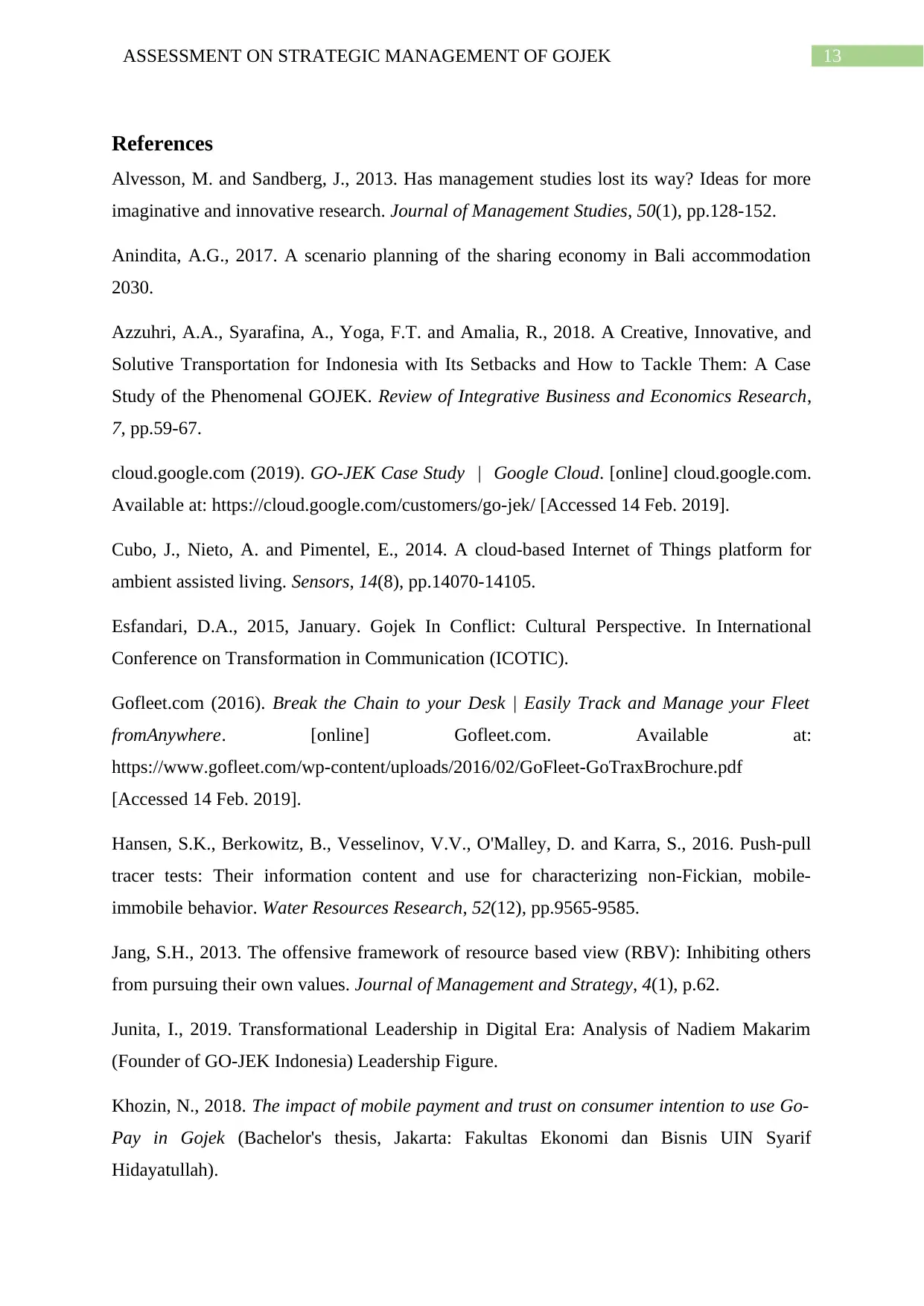
13ASSESSMENT ON STRATEGIC MANAGEMENT OF GOJEK
References
Alvesson, M. and Sandberg, J., 2013. Has management studies lost its way? Ideas for more
imaginative and innovative research. Journal of Management Studies, 50(1), pp.128-152.
Anindita, A.G., 2017. A scenario planning of the sharing economy in Bali accommodation
2030.
Azzuhri, A.A., Syarafina, A., Yoga, F.T. and Amalia, R., 2018. A Creative, Innovative, and
Solutive Transportation for Indonesia with Its Setbacks and How to Tackle Them: A Case
Study of the Phenomenal GOJEK. Review of Integrative Business and Economics Research,
7, pp.59-67.
cloud.google.com (2019). GO-JEK Case Study | Google Cloud. [online] cloud.google.com.
Available at: https://cloud.google.com/customers/go-jek/ [Accessed 14 Feb. 2019].
Cubo, J., Nieto, A. and Pimentel, E., 2014. A cloud-based Internet of Things platform for
ambient assisted living. Sensors, 14(8), pp.14070-14105.
Esfandari, D.A., 2015, January. Gojek In Conflict: Cultural Perspective. In International
Conference on Transformation in Communication (ICOTIC).
Gofleet.com (2016). Break the Chain to your Desk | Easily Track and Manage your Fleet
fromAnywhere. [online] Gofleet.com. Available at:
https://www.gofleet.com/wp-content/uploads/2016/02/GoFleet-GoTraxBrochure.pdf
[Accessed 14 Feb. 2019].
Hansen, S.K., Berkowitz, B., Vesselinov, V.V., O'Malley, D. and Karra, S., 2016. Push‐pull
tracer tests: Their information content and use for characterizing non‐Fickian, mobile‐
immobile behavior. Water Resources Research, 52(12), pp.9565-9585.
Jang, S.H., 2013. The offensive framework of resource based view (RBV): Inhibiting others
from pursuing their own values. Journal of Management and Strategy, 4(1), p.62.
Junita, I., 2019. Transformational Leadership in Digital Era: Analysis of Nadiem Makarim
(Founder of GO-JEK Indonesia) Leadership Figure.
Khozin, N., 2018. The impact of mobile payment and trust on consumer intention to use Go-
Pay in Gojek (Bachelor's thesis, Jakarta: Fakultas Ekonomi dan Bisnis UIN Syarif
Hidayatullah).
References
Alvesson, M. and Sandberg, J., 2013. Has management studies lost its way? Ideas for more
imaginative and innovative research. Journal of Management Studies, 50(1), pp.128-152.
Anindita, A.G., 2017. A scenario planning of the sharing economy in Bali accommodation
2030.
Azzuhri, A.A., Syarafina, A., Yoga, F.T. and Amalia, R., 2018. A Creative, Innovative, and
Solutive Transportation for Indonesia with Its Setbacks and How to Tackle Them: A Case
Study of the Phenomenal GOJEK. Review of Integrative Business and Economics Research,
7, pp.59-67.
cloud.google.com (2019). GO-JEK Case Study | Google Cloud. [online] cloud.google.com.
Available at: https://cloud.google.com/customers/go-jek/ [Accessed 14 Feb. 2019].
Cubo, J., Nieto, A. and Pimentel, E., 2014. A cloud-based Internet of Things platform for
ambient assisted living. Sensors, 14(8), pp.14070-14105.
Esfandari, D.A., 2015, January. Gojek In Conflict: Cultural Perspective. In International
Conference on Transformation in Communication (ICOTIC).
Gofleet.com (2016). Break the Chain to your Desk | Easily Track and Manage your Fleet
fromAnywhere. [online] Gofleet.com. Available at:
https://www.gofleet.com/wp-content/uploads/2016/02/GoFleet-GoTraxBrochure.pdf
[Accessed 14 Feb. 2019].
Hansen, S.K., Berkowitz, B., Vesselinov, V.V., O'Malley, D. and Karra, S., 2016. Push‐pull
tracer tests: Their information content and use for characterizing non‐Fickian, mobile‐
immobile behavior. Water Resources Research, 52(12), pp.9565-9585.
Jang, S.H., 2013. The offensive framework of resource based view (RBV): Inhibiting others
from pursuing their own values. Journal of Management and Strategy, 4(1), p.62.
Junita, I., 2019. Transformational Leadership in Digital Era: Analysis of Nadiem Makarim
(Founder of GO-JEK Indonesia) Leadership Figure.
Khozin, N., 2018. The impact of mobile payment and trust on consumer intention to use Go-
Pay in Gojek (Bachelor's thesis, Jakarta: Fakultas Ekonomi dan Bisnis UIN Syarif
Hidayatullah).
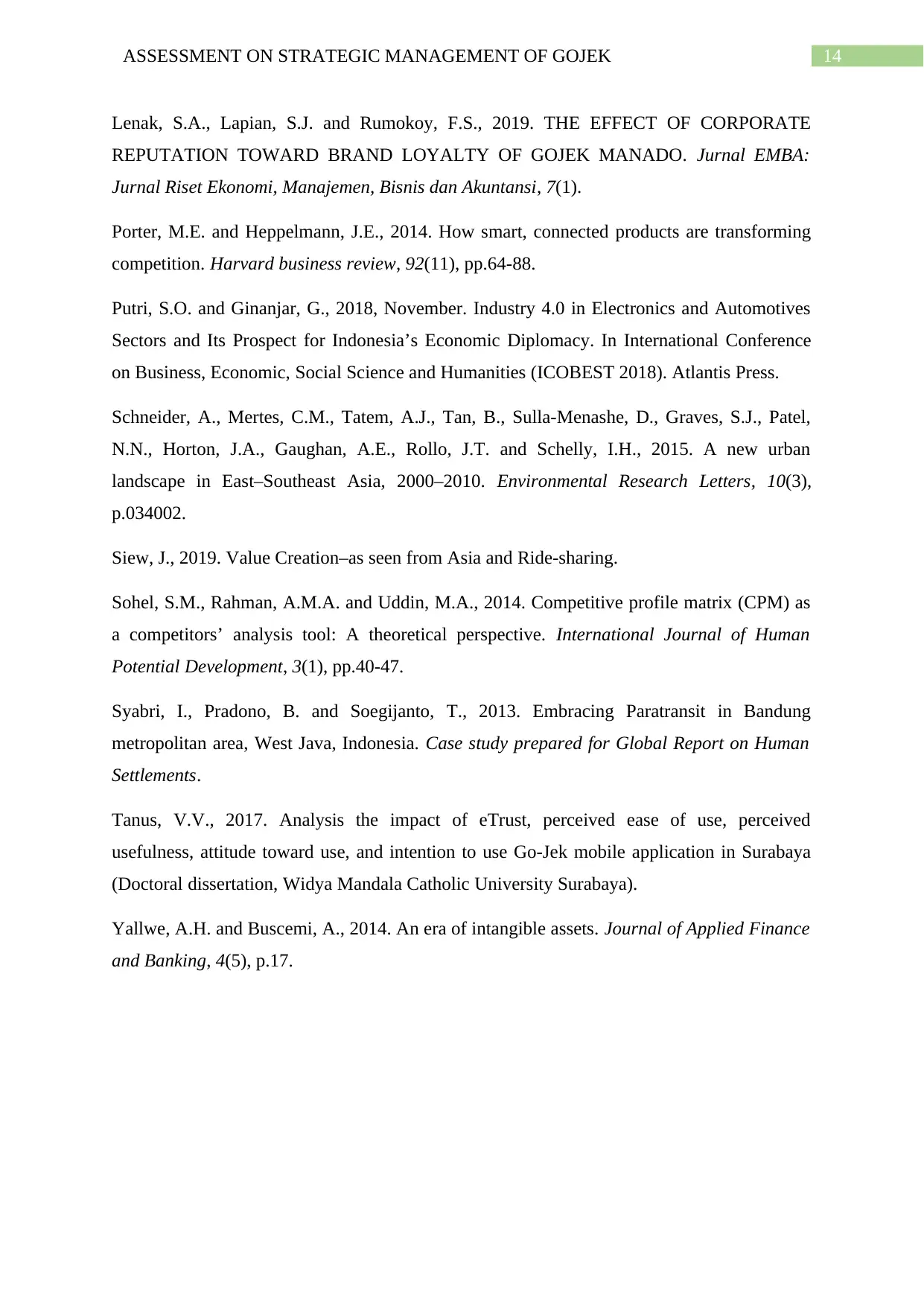
14ASSESSMENT ON STRATEGIC MANAGEMENT OF GOJEK
Lenak, S.A., Lapian, S.J. and Rumokoy, F.S., 2019. THE EFFECT OF CORPORATE
REPUTATION TOWARD BRAND LOYALTY OF GOJEK MANADO. Jurnal EMBA:
Jurnal Riset Ekonomi, Manajemen, Bisnis dan Akuntansi, 7(1).
Porter, M.E. and Heppelmann, J.E., 2014. How smart, connected products are transforming
competition. Harvard business review, 92(11), pp.64-88.
Putri, S.O. and Ginanjar, G., 2018, November. Industry 4.0 in Electronics and Automotives
Sectors and Its Prospect for Indonesia’s Economic Diplomacy. In International Conference
on Business, Economic, Social Science and Humanities (ICOBEST 2018). Atlantis Press.
Schneider, A., Mertes, C.M., Tatem, A.J., Tan, B., Sulla-Menashe, D., Graves, S.J., Patel,
N.N., Horton, J.A., Gaughan, A.E., Rollo, J.T. and Schelly, I.H., 2015. A new urban
landscape in East–Southeast Asia, 2000–2010. Environmental Research Letters, 10(3),
p.034002.
Siew, J., 2019. Value Creation–as seen from Asia and Ride-sharing.
Sohel, S.M., Rahman, A.M.A. and Uddin, M.A., 2014. Competitive profile matrix (CPM) as
a competitors’ analysis tool: A theoretical perspective. International Journal of Human
Potential Development, 3(1), pp.40-47.
Syabri, I., Pradono, B. and Soegijanto, T., 2013. Embracing Paratransit in Bandung
metropolitan area, West Java, Indonesia. Case study prepared for Global Report on Human
Settlements.
Tanus, V.V., 2017. Analysis the impact of eTrust, perceived ease of use, perceived
usefulness, attitude toward use, and intention to use Go-Jek mobile application in Surabaya
(Doctoral dissertation, Widya Mandala Catholic University Surabaya).
Yallwe, A.H. and Buscemi, A., 2014. An era of intangible assets. Journal of Applied Finance
and Banking, 4(5), p.17.
Lenak, S.A., Lapian, S.J. and Rumokoy, F.S., 2019. THE EFFECT OF CORPORATE
REPUTATION TOWARD BRAND LOYALTY OF GOJEK MANADO. Jurnal EMBA:
Jurnal Riset Ekonomi, Manajemen, Bisnis dan Akuntansi, 7(1).
Porter, M.E. and Heppelmann, J.E., 2014. How smart, connected products are transforming
competition. Harvard business review, 92(11), pp.64-88.
Putri, S.O. and Ginanjar, G., 2018, November. Industry 4.0 in Electronics and Automotives
Sectors and Its Prospect for Indonesia’s Economic Diplomacy. In International Conference
on Business, Economic, Social Science and Humanities (ICOBEST 2018). Atlantis Press.
Schneider, A., Mertes, C.M., Tatem, A.J., Tan, B., Sulla-Menashe, D., Graves, S.J., Patel,
N.N., Horton, J.A., Gaughan, A.E., Rollo, J.T. and Schelly, I.H., 2015. A new urban
landscape in East–Southeast Asia, 2000–2010. Environmental Research Letters, 10(3),
p.034002.
Siew, J., 2019. Value Creation–as seen from Asia and Ride-sharing.
Sohel, S.M., Rahman, A.M.A. and Uddin, M.A., 2014. Competitive profile matrix (CPM) as
a competitors’ analysis tool: A theoretical perspective. International Journal of Human
Potential Development, 3(1), pp.40-47.
Syabri, I., Pradono, B. and Soegijanto, T., 2013. Embracing Paratransit in Bandung
metropolitan area, West Java, Indonesia. Case study prepared for Global Report on Human
Settlements.
Tanus, V.V., 2017. Analysis the impact of eTrust, perceived ease of use, perceived
usefulness, attitude toward use, and intention to use Go-Jek mobile application in Surabaya
(Doctoral dissertation, Widya Mandala Catholic University Surabaya).
Yallwe, A.H. and Buscemi, A., 2014. An era of intangible assets. Journal of Applied Finance
and Banking, 4(5), p.17.
1 out of 15
Related Documents
Your All-in-One AI-Powered Toolkit for Academic Success.
+13062052269
info@desklib.com
Available 24*7 on WhatsApp / Email
![[object Object]](/_next/static/media/star-bottom.7253800d.svg)
Unlock your academic potential
© 2024 | Zucol Services PVT LTD | All rights reserved.





